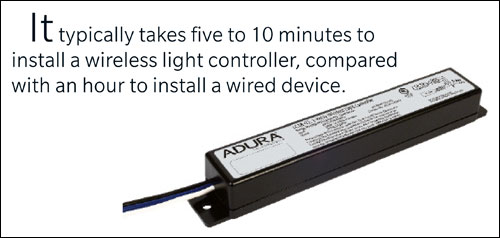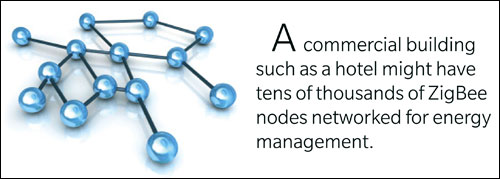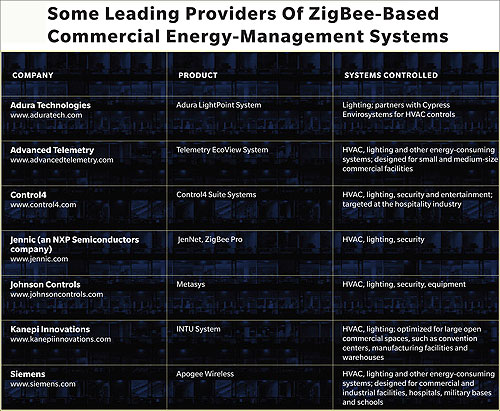Feb 01, 2011Energy management may make the top-10 list of most popular words and phrases for 2011. That's because it's the key to saving energy—and money—in your organization (as well as your home). Energy costs account for a huge portion of most companies' operating expenses, so monitoring, controlling and conserving a building's lighting, heating and cooling, and other energy-hungry systems can lead to substantial savings. Several energy-management vendors report that customers have shrunk their power bills by at least 30 percent. Saving energy also means lowering your carbon footprint, which could help reduce carbon taxes and promote a green image, another plus for business.
Energy management is gaining popularity, too, because emerging radio frequency (RF) solutions for managing power consumption—many based on ZigBee technology—are easier to install and less expensive than wired systems. The RF systems rely on low-power wireless sensor networks (WSNs). They can link together controllers for a building's heating, ventilating and air-conditioning (HVAC) system, lighting, equipment and other devices, allowing data about energy consumption and environmental factors, such as temperature or humidity, to be collected, transmitted and analyzed.
This gives property owners and building managers the ability to better control their energy usage, often from a Web-based interface on personal computers, touch screens or, increasingly, handheld devices. They can, for example, reduce the amount of electric lighting used in common areas of a commercial building during the daytime, when natural light is available. At the 4,000-room luxury Aria Resort & Casino, in Las Vegas, which opened in December 2009, an automation and energy-management system helps the hotel contain energy costs by controlling the lights, televisions and temperatures in unoccupied rooms, according to Susan Cashen, VP of marketing for Control4, which developed the solution. The system, which is activated by a guest's RFID-enabled room key, also plays music and opens the curtains, enhancing the guest experience, Cashen says.
In the United States, energy management is getting a strong push from the federal government. Billions of dollars in stimulus funds are being spent on smart-grid efforts, to upgrade the country's aging metering infrastructure at both businesses and homes. The U.S. Department of Energy (DOE) has also been pumping millions of dollars into energy-management grants for commercial and institutional entities. Last fall, the DOE released a report outlining strategies for commercial buildings and hospitals to achieve energy savings of up to 50 percent, and recommended using wireless sensors to regulate lighting and other systems in unoccupied areas.
It typically takes five to 10 minutes to install a wireless light controller, compared with an hour to install a wired device, says Zach Gentry, chief strategy officer of Adura Technologies, a San Francisco-based startup that sells a lighting-management system. In addition, there is not a lot of equipment involved in the installation, he says; to rig a 90,000-square-foot building, for instance, you would need just a couple of moving boxes full of controllers, sensor interfaces and gateways.
WSNs also have made energy-management systems affordable for small and medium-size buildings. Commercial buildings that range from 5,000 square feet to 20,000 square feet are viewed as "low-hanging fruit" in terms of being ripe for energy management, says Mareca Hatler, research director at ON World, a research firm that tracks smart technology markets.
Given that energy costs for commercial buildings can drain operating budgets, savings through energy management, in some cases, provide a return on investment within a year, according to some vendors. "In the commercial building market, the ROI has been proven," Hatler says. Other analysts agree. On a 100,000-square-foot building outfitted with an energy-management system, you could expect to see payback in about 2.5 years, according to Jevan Fox, a research analyst with Pike Research's smart energy practice. The U.S. market for building energy-management systems will grow from $900 million in 2010 to $2.4 billion by 2016, Pike Research forecasts, driven largely by the attractive ROI the systems offer.
A catalyst for much of the development in energy-management products is rapid adoption of the wireless technology ZigBee, the specification for a suite of high-level communication protocols for small, low-cost, low-power digital radios. Based on the IEEE 802.15.4 wireless standard, ZigBee is targeted at RF applications requiring a low data rate and long battery life. With a maximum transmission rate of 250 kilobits per second—far slower than other wireless protocols, such as Wi-Fi or Bluetooth—ZigBee is designed to convey small packets of data in a secure network environment. With a typical transmission range of about 50 meters (164 feet), ZigBee nodes are intended to be in close proximity to one another. As a result, a commercial building, such as a hotel, might have tens of thousands of ZigBee nodes networked for energy management.
"Using ZigBee for energy management, and home and building automation, really lets people save energy and money, while also increasing their comfort and convenience," says Bob Heile, chairman of the ZigBee Alliance, an industry association that has developed standards for the technology for both home and commercial applications. "Plus, utilities gain greater ability to manage their transmission and distribution systems, and set the stage for electric vehicles."
To view a larger version of the above table, click here.
ZigBee is the predominant technology used in WSNs, according to ON World (all the energy-management products featured in the table below are based on ZigBee technology). ZigBee annual unit sales jumped 62 percent from 2007 to 2010, according to the research firm, with annual unit sales expected to reach hundreds of millions in the next few years. "The technology is maturing," Hatler says. "There are a lot more products available."
The market for energy-management systems is expected to get another boost early this year with the ZigBee Alliance's anticipated approval of the ZigBee Building Automation Profile, which will set the standards to ensure interoperability between products from different manufacturers. While each member determines its own product-development timetable, Heile says, it typically takes members 12 months to 18 months to create ZigBee-certified products ready for the marketplace.
Energy-Management Providers
Many long-time building-control and HVAC suppliers, such as Johnson Controls and Siemens, have added wireless energy- management options to their product lines, offering wireless thermostats and other equipment, software, installation and training. Siemens' Apogee Wireless System, for example, is designed to control and manage HVAC, lighting and security. Adura Technologies' LightPoint System manages only lighting, but the company has partnered with Cypress Envirosystems to add HVAC management to its offering.
Generally, ZigBee energy-management systems consist of wireless controllers, sensor interfaces, gateways—the lightweight computers that act as a bridge to back-end IT systems—and software for monitoring and analyzing all the data on energy usage. For businesses that don't want to handle all the data analysis that comes from tracking and managing their energy use, several companies offer cloud-based services.
Under this model, the firms provide customers with energy monitoring, conduct analytics on usage patterns and send alerts about pricing or power consumption. Some providers, such as Adura, offer both cloud-based and enterprise energy-monitoring software, for companies not comfortable having their applications hosted by an outside party, Gentry says.
What's Ahead
The heightened interest in energy management is drawing new entrants into the market and sparking acquisitions. Last fall, for instance, Cisco purchased Arch Rock, a company that developed a wireless mesh technology for smart-grid applications. And late last year, Siemens acquired Site Controls, a provider of energy-management solutions for multisite commercial businesses, and SureGrid, a software firm that offers cloud-based energy monitoring and management of HVAC systems.
At the same time, vendors are developing new features and applications for their energy-management systems. Building managers can now access real-time data from WSNs on devices such as iPads and iPhones, so they can set controls for energy use remotely. Adura Technologies' solution not only provides real-time performance monitoring of your lighting system's energy use, it can also alert you to problems. And Johnson Controls offers tools that let you collect the data you need to report your energy use and carbon emissions.
As energy-management products continue to evolve, there will be more integration with related predictive data from outside sources, such as weather forecasts, according to Pike Research's Fox. "The technology is becoming more active," Fox says. "It's not just analyzing data, but pulling in [information such as] five-day forecasts." With no shortage of energy-management products and services, it's a good time for businesses to slash their utility bills and shrink their environmental footprints.
As governments worldwide develop smart grids to meet their countries' energy needs, many vendors are betting the digital electricity network will usher in a new age of control and efficiency in the home. Startups and established players—including home-automation suppliers, cable operators and telecommunications providers—are investing billions of dollars to develop home energy-management products and services, to help consumers lower their energy bills.
While analysts believe the market has a bright future, it's just starting to take shape. "Things are still in the early stage with consumer adoption," says Mareca Hatler, research director for ON World, a research firm that tracks the smart technology industry. ON World forecasts that the global smart energy home market will reach $3 billion by 2014.
Spurring much of the energy management development in the United States is the infusion of billions of dollars of federal stimulus money for smart-grid technology. The smart meters being installed at millions of homes allow for two-way communication between the home and utility company, providing real-time data about electricity usage. This information enables utilities to monitor and meet demand, and lets consumers reduce energy consumption and costs by, for instance, using appliances at off-peak hours when rates are lower.
To facilitate home energy management, companies are developing ZigBee-based products that enable communication between household devices, such as thermostats and lighting controllers, and smart meters. Consumers can use touch screens at home to monitor and control their energy consumption, and they can access the systems remotely with Web browsers and handheld devices such as smart phones. If, for instance, a homeowner leaves for work and then realizes he left the lights on in the house, he could use his iPhone to access the energy-management platform and turn them off.
Control4, PassivSystems and Tendril are among the startups offering ZigBee-based energy-management products for the home. Comcast, General Electric (GE), Verizon and other well-established companies are rolling out their own products for the home energy market. Some systems will be available as standalone products or add-ons to existing home-automation systems, and others will be available through service providers.
One day, consumers will purchase energy-management "starter kits" or "booster packs" at stores such as Best Buy or Home Depot, says ZigBee Alliance chairman Bob Heile. But before the masses line up at big-box retailers with their credit cards, system suppliers will have to convince people of the benefits energy management offers, he adds. " A big consumer education piece has to happen," Heile says. "This is not 'build it and they will come.'"




